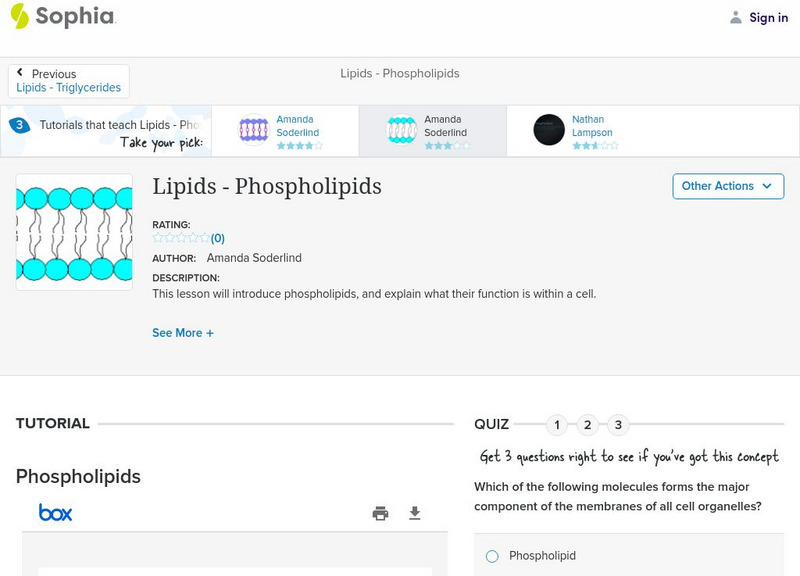Sophia Learning
Sophia: Lipids Phospholipids: Lesson 1
This lesson will introduce phospholipids, and explain what their function is within a cell. It is 1 of 3 in the series titled "Lipids - Phospholipids."
Sophia Learning
Sophia: Lipids Triglycerides: Lesson 3
This lesson will describe the structure of a triglyceride, and show the differences between saturated and unsaturated fats. It is 3 of 3 in the series titled "Lipids - Triglycerides."
Sophia Learning
Sophia: Lipids Phospholipids: Lesson 3
This lesson will introduce phospholipids, and explain what their function is within a cell. It is 3 of 3 in the series titled "Lipids - Phospholipids."
Other
Cyberlipid: Simple Lipids: Acylglycerols or Glycerides
This site explains what glycerides are and why they are so important.
Other
Hypertextbook: Large Molecules
This is a good, in-depth reference for the study of macromolecules in biology - lipids, proteins and carbohydrates. Includes images and links to other sources as well as a quiz for students to check understanding.
Concord Consortium
The Concord Consortium: Molecular Workbench Lipids Forming a Monolayer
Interact with lipids and see how they form a monolayer in water and oil.
Ohio State University
Ohio State University: Lipids and Carbohydrates
An introduction to these chemical families. Diagrams are easy to understand and the text explains basic concepts well.
Other
Story md.com: Wellness and Nutrition: Fats
Fats are part of a larger family of molecules known as lipids. Lipids occur naturally in your body and can also be ingested through the foods in your diet. Which fats are healthy and which should you avoid? The answer may surprise you.
CPALMS
Florida State University Cpalms: Florida Students: Macromolecules of Life: The Overview
Get a tour of the four basic biological macromolecules structure and function in this tutorial. Learn about carbohydrates, lipids, proteins, and nucleic acids.
OpenStax
Open Stax: Anatomy & Physiology: Chemical Digestion/absorption: A Closer Look
In this module, find out the locations and primary secretions involved in the chemical digestion of carbohydrates, proteins, lipids, and nucleic acids.
CK-12 Foundation
Ck 12: Life Science: Organic Compounds
[Free Registration/Login may be required to access all resource tools.] The main chemical components of living organisms are known as organic compounds and are built around the element carbon. Living things are made up of very large...
Chem4kids
Chem4 Kids: Browsing Biochemistry
Here you can learn about biochemistry, the chemistry of the living world. Content explores carbohydrates, lipids, amino acid structure and proteins, enzymes, nucleic acids, and metabolism.
Khan Academy
Khan Academy: Connections Between Cellular Respiration and Other Pathways
Resource examines how non-glucose molecules such as carbohydrates, proteins, and lipids enter the cellular respiration pathway. Also, looks at the use of cellular respiration intermediates for biosynthesis.
University of Arizona
The Biology Project: Cell Membrane Tutorial
Great overview of cell membranes. The site presents the information as a tutorial with multiple choice questions to guide the learner. Very well designed site on cell membranes.
Howard Hughes Medical Institute
Hhmi: Biointeractive: Obesity: The Fate of Fat
See how dietary fat from food we eat travels through the digestive system, and gets packaged and stored in the human body. [2:07]
Concord Consortium
Concord Consortium: Stem Resources: The Tree of Life's Molecules
An interactive activity where you can zoom in to explore the macromolecules present in organisms. Learn about proteins, carbohydrates, lipids, and nucleic acid as you investigate the molecular structure of these types of macromolecules....
Estrella Mountain Community College
Online Biology Book: Chemistry Ii: Water and Organic Molecules
Online biology textbook discussing the chemical nature of water, and the importance of its molecular structure to life. Also discusses at length the organic molecules nucleic acids, proteins, lipids, and carbohydrates.
BBC
Bbc: Gcse Bitesize: Animal Organization Digestion Aqa
This lesson focuses on the structures of carbohydrates, proteins, and lipids including defining terms, a brief discussion of what they do, and diagrams of each. It also provides a link to a test.
Other
Dr. Paul's Virtually Biology Show: Lipids and Fats Phospholipids
See a good overview of what phospholipids are and the role they play.
Palomar Community College District
Palomar College: Molecular Level of Genetics
Investigate the four categories of biomolecules: carbohydrates, lipids, proteins and nucleic acids in this resource.
CK-12 Foundation
Ck 12: Life Science: Types of Nutrients
[Free Registration/Login may be required to access all resource tools.] Carbohydrates, proteins, and lipids contain energy. When your body digests food, it breaks down the molecules of these nutrients. This releases the energy so your...
Bryn Mawr College
Serendip: Who Took Jerell's I Pod? An Organic Compound Mystery
Brief text summary of what students learn in the Who Took Jerell's iPod? lab along with links to download Student Handouts and Teacher Preparation Notes in PDF or Word formats. Students are challenged to solve a mystery by testing for...
BBC
Bbc: Gcse Bitesize: Animal Organization Digestion
The major nutrients required for a healthy diet are carbohydrates, proteins, and lipids. The digestive system breaks down large molecules of food, which are then absorbed into the bloodstream. After reading, try the quiz.
BiologyWise
Biology Wise: The Smooth Endoplasmic Reticulum and Its Function
The difference between the smooth and the rough endoplasmic reticula is described, as well as the functions of the smooth endoplasmic reticulum. These functions include the synthesis of carbohydrates and lipids, protein transport, and...
Other popular searches
- Lipid Membrane
- Carbohydrates and Lipids
- Macromolecules Lipids
- Lipids and Proteins
- Proteins Lipids
- Activity on Lipids
- Lipids in Foods
- Carbohydrates Lipids
- Lipids in Cell Membranes
- Over Lipids
- Lipids Game
- Carbo Lipids Nucleic Acids


















